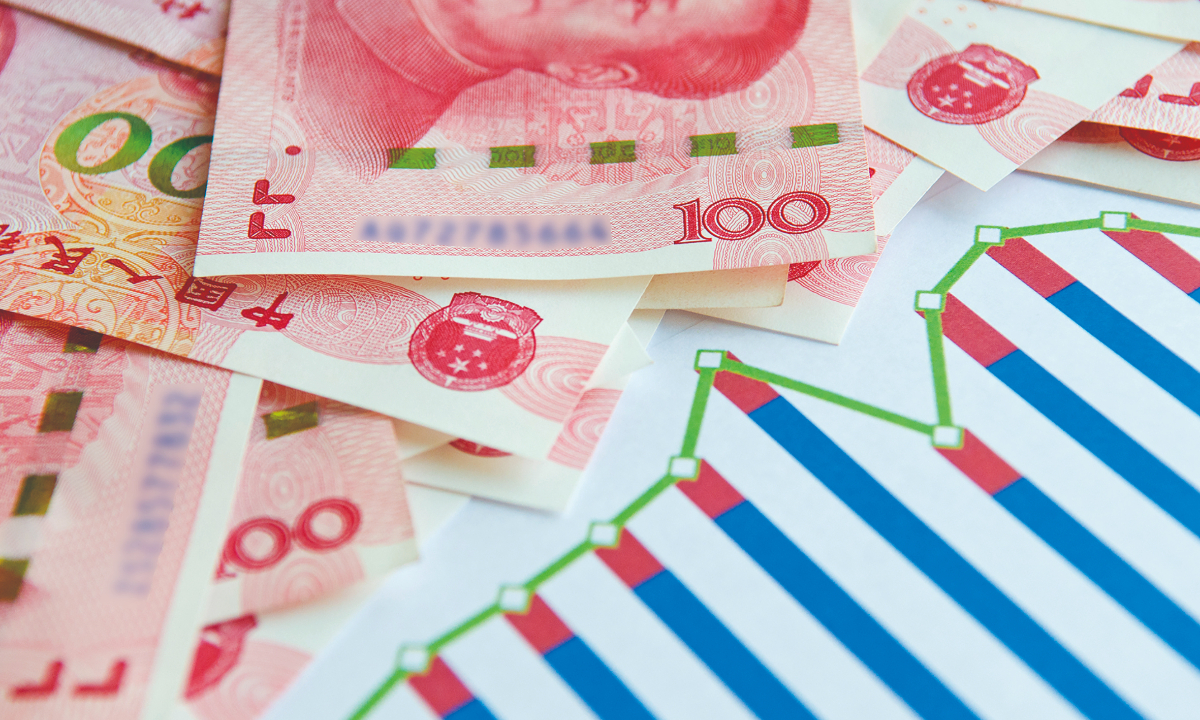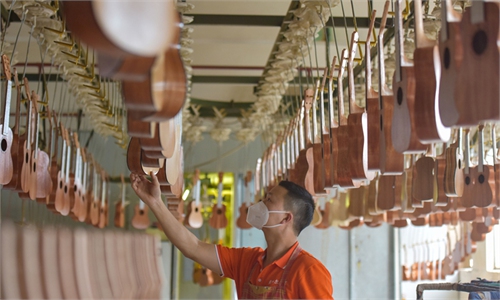Chinese yuan’s depreciation favors export enterprises, stability of exchange rate keeps national economy resilient
Stability of Chinese currency exchange rate contributing to national economy: expert

The offshore yuan exchange rate falls below 6.73 intraday, while the onshore yuan exchange rate depreciates by more than 500 points intraday on May 6, 2022. Photo: IC
“The depreciation of the Chinese yuan in the short term is an obvious benefit to my company. For example, if I sell a laptop at $1,000, I can only get 6,300 yuan ($945.02) when I receive the payment at the original exchange rate, but now I get 6,700 yuan. Therefore, the cash flow of the whole company has increased with more profit,” Yang Lihua, general manager from Chuwi, a consumer electronics company with a focus on overseas markets, said in an interview with the Global Times on Friday.
The yuan began to depreciate rapidly against the dollar on April 19 this year, with a devaluation of nearly 5 percent over half a month. The sudden slide of the Chinese currency, which has been strong, has brought obvious benefits to foreign trade companies like Chuwi.
Experts noted that a basically stable exchange rate of Chinese currency is more beneficial to the country’s overall economy amid the resurgence of COVID-19 flare-ups and geopolitical uncertainty.
Higher profit
According to Yang, the company’s business operations have been significantly impacted amid shrinking overseas market demand, rising bulk raw material prices and soaring international freight rates due to the pandemic.
Yang said that he originally did not pay attention to the exchange rate, but when his profit margin was being squeezed and the exchange loss directly affect the company's profit, he started to focus on the yuan’s exchange rate every day.
“The 5-percent fall of yuan equates to a 5-point increase in the company's profit margin, which means companies that were in the red may now start to make a profit,” Yang noted.
Among the major global currencies, the euro and the Japanese yen have continued to depreciate against the Chinese yuan, which has had a clear impact on Chuwi's markets in Europe and Japan.
“The yen has depreciated by 10 percent since the beginning of the year," said Yang, adding that the company has to raise prices at the Japanese sales terminal according to its profit and loss needs, which may affect its market competitiveness.
However, since late April, the yen rises as the yuan weakens and Yang no longer needs to adjust prices. “At present, the foreign trade industry needs Chinese currency to fall properly, and it may be better if it can depreciate some more on this basis,” Yang said.
In addition to Yang’s company, a number of export enterprises have benefited from the yuan’s rapid depreciation, combined with other favorable factors like preferential rules under the Regional Comprehensive Economic Partnership (RCEP) umbrella.
Wada Taro, founder of Gouba Trading Company, which focuses on cross-border business in between China and Japan, told the Global Times that the company is benefiting from both the RCEP and exchange rate changes.
At present, China's tariff rate on Japanese sake stands at 40 percent, and it will be completely eliminated by the 21st year after the RCEP took affect. Meanwhile, tariffs on China's exports to Japan, such as clothing, will also be gradually reduced to zero over 16 years.
Compared with the long-term benefits from the RCEP, the impact of the current exchange rate changes on the company's business is more intuitive. “With the rapid depreciation of Chinese yuan, our garments and daily necessities exported to Japan have a greater price advantage, which will expand our overseas sales,” he said.
Stability comes first
The long-term devaluation of the yen and the Korean won has led some market institutions to believe that the financial market seems to smell a hint of an Asian currency war.
The yuan’s devaluation stimulates exports, but also makes the country's currency and exports face a more complex environment.
“China is not only a major exporter, but also a big importer purchasing large amounts of energy and raw materials from around the world every year. Therefore, while the devaluation of the yuan is good for exports, it also takes into account the resulting rise in import costs and imported inflation,” Huo Jianguo, vice chairman of the China Society for World Trade Organization Studies in Beijing, told the Global Times.
Huo noted that yuan’s depreciation, on the whole, has its drawbacks and benefits for China, so keeping the yuan stable when it comes to the exchange rate is conductive to the overall economy.
According to the expert, the depreciation pressure on the yuan’s exchange rate is mainly caused by the country’s economic downward pressure due to the COVID-19 outbreak, while the dollar gained strength in the global market.
“But I think it is temporary because the dollar has limited room for appreciation. In addition, the recovery of market expectations after the epidemic is brought under control together with the rebound of exports, will support Chinese yuan at the exchange rate of 6.70 against the dollar,” Huo noted.
“The country’s economy and its exports performance determine its currency,” Huo said, adding that the yuan’s exchange rate will remain stable in the future.
The State Council, China’s cabinet, proposed to “maintain the basic stability of the yuan’s exchange rate” on Thursday, in a bid to avoid foreign trade enterprises facing excessive exchange risks.
China’s Vice Minister of Commerce Sheng Qiuping also said in an interview that the ministry will focus on improving the ability of foreign trade enterprises to deal with exchange rate risks.
China’s foreign exchange reserves amounted to $3.12 trillion by the end of April, down 2.14 percent compared with end of March, data from the State Administration of Foreign Exchange (SAFE) showed on Saturday.
A spokesperson from SAFE said that in April, the supply and demand in the domestic foreign exchange market remained basically balanced.

